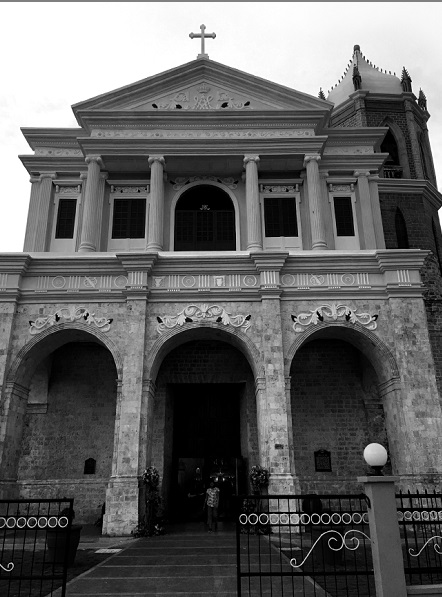
The facade of the fully restored Our Lady of Assumption Shrine which was turned over by the NHCP to the parish last August 14, 2017.
BOHOL EARTHQUAKE 4TH ANNIVERSARY
Located 3.1 kilometers southwest of Tagbilaran City, Bohol, is the town of Dauis on the island of Panglao.
Exactly four years ago, on October 15, 2013, parishioners witnessed portions of the town’s centuries-old church crumble when a 7.2-magnitude earthquake hit Bohol.
The tremor left the Our Lady of Assumption Shrine Parish in disarray after the church’s facade and part of its roof collapsed. Portions of its stone walls also cracked, and others were dislodged.
For months, parishioners heard Mass under the shade of an acacia tree where a makeshift altar was built beside the convent. They sat on monobloc chairs scattered on the church grounds.
To protect the miraculous image of Our Lady of Assumption and other religious icons as well as the church’s retablo, the parish set up tents.
After parish officials were able to gather enough funds, a small yet better altar was built on the same spot where the makeshift structure once stood.
Some church pews were later placed there although they were not enough, and others had to attend Mass sitting on benches and chairs under a tree.
Today, Our Lady of the Assumption Shrine, one of several heritage churches damaged by the quake including the Church of San Pedro Apostol, Loboc; Our Lady of Light, Loon; Santisima Trinidad Parish, Loay; Our Lady of the Immaculate Conception, Baclayon; San Nicolas Church, Dimiao; and Santa Cruz Parish Church in Maribojoc; once again stands majestically — spick and span — as though nothing had happened to it.
The church has been fully restored to its original form by national heritage agencies following years of hard work studying ways to bring back its beauty and glory.
‘OVERJOYED’
Last August 14, on the eve of the town’s fiesta, the National Historical Commission of the Philippines (NHCP) turned over to Diocese of Tagbilaran Bishop Alberto Uy and Parish Priest Desiderio Magdoza the completely restored church – a first for Bohol after the quake, as work continues on the other damaged churches.
NHCP Chairman Dr. Rene Escalante and Executive Director Ludivico Baduy, led the ceremonies at the portico of the newly-restored church which was witnessed by Bohol Governor Edgar Chatto, Dauis Mayor Marietta Sumaylo and other local officials.
The event was followed by a re-consecration of the shrine and a Holy Mass, the first to be heard inside the church since the quake.
“Ang pagbalik sa simbahan nagasimbolo sa kaayo sa katawhan diin gipakita nila nga andam sila sa pagtinabangay ilabi na sa panahon sa katalagman ug sa panahon diin ang ilang pagtuo sa Diyos gisulayan,” 57-year-old Celsa Aranas told Cebu Daily News, jubilant that she could now go back to attending Mass inside the church that she had gone to since childhood.
(The return of the church symbolizes the goodness of the people who showed that they are ready to help each other especially in times of tragedies and in times when their faith to God is being tested.)
Although it was heartbreaking to see their beautiful church go down together with several other centuries-old churches in the province, Aranas said the tragedy only served to strengthen her faith in God.
“Napalig-on hinuon ang akong pagsalig ug pagtuo sa Ginoo kay nasayod ako nga kining tanan pagsulay lamang ug mabalik kini sa normal tungod sa iyang dakong gugma sa katawhan,” she said.
(My faith in God was strengthened because I knew that all of these were just challenges and that everything will eventually return to normal because of His great love for the people.)
Church history
The first Spanish missionaries arrived in Dauis in 1697; but it was only in 1863 when construction of the present church began during the administration of Fr. Julio Saldaña. Between 1919 to 1923, Fr. Natalio del Mar continued to build the church. Religious symbols were painted on the church’s interior in the 1920’s to the 1940’s.
The church was inaugurated in 1923 by Msgr. Juan Gorordo.
Through time and even after the restoration, the 18th century structure has been able to sustain its artistic and architectural style which features Gothic, Greek columns, Baroque art, neo-classical retablos and Renaissance ceiling paintings. The church is a popular choice among event planners for weddings.
At the foot of the main altar, is another well-known feature of the church: a small well famous for its water’s healing power.
According to locals, the well originated from the Spanish era when it miraculously sprang up when people took refuge behind the locked doors of the church – without food and water- to evade the attack of pirates.
Since then, became a source of drinking water for nearby residents while many people, including tourists, believe in its miraculous power to heal.
The church was declared a National Historical Landmark by the NHCP in 2009.
“We are so overwhelmed that the church has reached complete reconstruction,” said
Parish Vicar Rommel Anico as he thanked NHCP for the funds to restore the damaged church which cost P33,738,344.29.
Anico noted that after the restoration, more people have started to hear mass in the church as attendance “double or tripled”.
“The devastation of the church four years ago affected the faith of the Dauisanons at some certain extent. And finally, when they see their church once again, their faith was awakened after a long period of stupor,” Anico said.
(TO BE CONTINUED)
